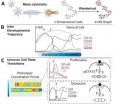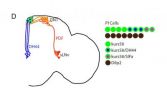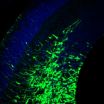(Press-News.org) WEST LAFAYETTE, Ind. - Purdue and West Virginia University researchers are the first to sequence the genome of the golden eagle, providing a bird's-eye view of eagle features that could lead to more effective conservation strategies.
Their study calls into question long-held assumptions about golden eagle vision, indicating that the raptors may not be as sensitive to ultraviolet light as previously thought. The genome also suggests that golden eagles could have a sharper sense of smell than researchers realized.
Additionally, the genome provides thousands of genetic markers that will help researchers track populations and monitor eagle mortality.
"Having the golden eagle genome in hand could directly affect the way we make conservation and management decisions," said Jacqueline Doyle, postdoctoral research associate and first author of the paper.
Though it is one of the most widespread avian species, the golden eagle is threatened throughout much of its range by poaching, shrinking habitats and fatal collisions with wind turbines. An estimated 67 golden eagles are killed annually at a single wind farm - the Altamont Pass Wind Resource Area in central California - a heavy toll on a species that reproduces slowly and can live up to 30 years, said J. Andrew DeWoody, professor of genetics and senior author of the study.
One recently proposed method of reducing turbine-related eagle deaths was to coat wind turbines with ultraviolet-reflective paint, thereby heightening their visibility to eagles, which were thought to be sensitive to ultraviolet light. But the golden eagle genome suggests that eagle vision is rooted in the violet spectrum - like human sight - rather than the ultraviolet.
"We find little genomic evidence that golden eagles are sensitive to ultraviolet light," Doyle said. "Painting wind turbines with ultraviolet-reflective paint is probably not going to prevent eagles from colliding with turbines."
Analysis of the genome also revealed that golden eagles have far more genes associated with smell than previously realized, indicating that the birds might use smell to locate prey more than researchers thought.
Doyle used the genome to identify thousands of genetic markers that together could act as a DNA "fingerprint," allowing researchers to distinguish individual birds, follow them in a population and determine population size and flux, parentage and genetic variation.
DeWoody said the markers would also help scientists track the evolution of different families of genes and identify potential golden eagle pathogens, parasites and symbiotic organisms.
The researchers generated the genome by extracting DNA from a blood sample of a golden eagle that was captured with a spring-loaded net in California. The eagle was outfitted with a Global Positioning System tracking device before its release, making it possibly the first animal to have its genome sequenced and be tracked at the same time, DeWoody said.
Team leader Todd Katzner, a research assistant professor at West Virginia University, said the GPS device could allow the team to relate the individual movements and behavior of the golden eagle to its genome.
DeWoody said the golden eagle "truly represents the wild. We want to preserve and conserve this species for future generations, and the genome will improve our ability to do that."
INFORMATION:
The paper was published Wednesday (April 23) in PLOS ONE and is available at http://www.plosone.org/article/info%3Adoi%2F10.1371%2Fjournal.pone.0095599.
The U.S. Bureau of Land Management, the California Department of Fish and Wildlife and the Purdue University Provost's Office provided funding for the research.
Genome yields insights into golden eagle vision, smell
2014-04-24
ELSE PRESS RELEASES FROM THIS DATE:
International collaboration unravels novel mechanism for neurological disorder
2014-04-24
HOUSTON – (April 24, 2014) – A team of international scientists led by Baylor College of Medicine has discovered a novel gene (CLP1) associated with a neurological disorder affecting both the peripheral and central nervous systems. Together with scientists in Vienna they show that disturbance of a very basic biological process, tRNA biogenesis, can result in cell death of neural progenitor cells. This leads to abnormal brain development and a small head circumference as well as dysfunction of peripheral nerves.
The study published today in the current issue of the journal ...
Researchers create comprehensive map of human B cell development
2014-04-24
New York, NY - In the April 24, 2014 edition of Cell, a team of researchers led by Dana Pe'er at Columbia University and Garry Nolan at Stanford University describes a powerful new method for mapping cellular development at the single cell level. By combining emerging technologies for studying single cells with a new, advanced computational algorithm, they have created the most comprehensive map ever made of human B cell development. Their approach will greatly improve researchers' ability to investigate development in cells of all types, make it possible to identify rare ...
Surprising new insights into the PTEN tumor suppressor gene
2014-04-24
BOSTON – Ever since it was first identified more than 15 years ago, the PTEN gene has been known to play an integral role in preventing the onset and progression of numerous cancers. Consequently, when PTEN is either lost or mutated, malignant cells can grow unchecked and cancer can develop.
Now a team led by investigators at Beth Israel Deaconess Medical Center (BIDMC) helps explain more precisely how PTEN exerts its anti-cancer effects and how its loss or alteration can set cells on a cancerous course. The new study, which reveals that PTEN loss and PTEN mutations are ...
Researchers pinpoint protein crucial for development of biological rhythms in mice
2014-04-24
Johns Hopkins researchers report that they have identified a protein essential to the formation of the tiny brain region in mice that coordinates sleep-wake cycles and other so-called circadian rhythms.
By disabling the gene for that key protein in test animals, the scientists were able to home in on the mechanism by which that brain region, known as the suprachiasmatic nucleus or SCN, becomes the body's master clock while the embryo is developing.
The results of their experiments, reported online April 24 in Cell Reports, are an important step toward understanding ...
Oldest pterodactyloid species discovered, named by international team of researchers
2014-04-24
WASHINGTON—An international research team, including a George Washington University (GW) professor, has discovered and named the earliest and most primitive pterodactyloid—a group of flying reptiles that would go on to become the largest known flying creatures to have ever existed—and established they flew above the earth some 163 million years ago, longer than previously known.
Working from a fossil discovered in northwest China, the project—led by University of South Florida (USF) paleontologist Brian Andres, James Clark of the GW Columbian College of Arts and Sciences ...
Fruit fly study identifies brain circuit that drives daily cycles of rest, activity
2014-04-24
PHILADELPHIA - Amita Sehgal, PhD, a professor of Neuroscience at the Perelman School of Medicine, University of Pennsylvania, describes in Cell a circuit in the brain of fruit flies that controls their daily, rhythmic behavior of rest and activity. The new study also found that the fly version of the human brain protein known as corticotrophin releasing factor (CRF) is a major coordinating molecule in this circuit. Fly CRF, called DH44, is required for rest/activity cycles and is produced in cells that receive input from the clock cells in the fly brain. In mammals, CRF ...
Scientists find way to target cells resistant to chemo
2014-04-24
Scientists from The University of Manchester have identified a way to sensitise cancer cells to chemotherapy - making them more open to treatment.
The study published today in Cell Reports, could pave the way for the development of drugs to target cells that have become resistant to treatment.
The research team made the discovery whilst exploring the possible mechanisms behind resistance to chemotherapy drugs like Paclitaxel, often used to treat breast and colon cancer.
Dr Andrew Gilmore, who led the research team at The University of Manchester, is part of both the ...
New type of protein action found to regulate development
2014-04-24
Johns Hopkins researchers report they have figured out how the aptly named protein Botch blocks the signaling protein called Notch, which helps regulate development. In a report on the discovery, to appear online April 24 in the journal Cell Reports, the scientists say they expect the work to lead to a better understanding of how a single protein, Notch, directs actions needed for the healthy development of organs as diverse as brains and kidneys.
The Johns Hopkins team says their experiments show that Botch uses a never-before-seen mechanism, replacing one chemical group ...
Researchers discover new genetic brain disorder in humans
2014-04-24
A newly identified genetic disorder associated with degeneration of the central and peripheral nervous systems in humans, along with the genetic cause, is reported in the April 24, 2014 issue of Cell.
The findings were generated by two independent but collaborative scientific teams, one based primarily at Baylor College of Medicine and the Austrian Academy of Sciences, the other at the University of California, San Diego School of Medicine, the Academic Medical Center (AMC) in the Netherlands and the Yale University School of Medicine.
By performing DNA sequencing ...
Scientists reprogram blood cells into blood stem cells in mice
2014-04-24
BOSTON (April 24, 2014)—Researchers at Boston Children's Hospital have reprogrammed mature blood cells from mice into blood-forming hematopoietic stem cells (HSCs), using a cocktail of eight genetic switches called transcription factors. The reprogrammed cells, which the researchers have dubbed induced HSCs (iHSCs), have the functional hallmarks of HSCs, are able to self-renew like HSCs, and can give rise to all of the cellular components of the blood like HSCs.
The findings mark a significant step toward one of the most sought-after goals of regenerative medicine: the ...






